



The 13th Battalion, 20th Engineers
The 41st and 42nd Engineers
Note: Most of the text of this article comes from "TWENTIETH ENGINEERS -- FRANCE -- 1917-1918-1919"
The Forty-First Engineers and 13th Battalion, 20th Engineers
Plans for the formation of an auxiliary battalion of the Twentieth Engineers were perfected in December, 1917, and organization was commenced at Camp American University, D. C., early in January. As planned, the duties of the new unit were principally the building of roads and bridge production and delivery of forest products. Recruits arriving at Washington were assigned, and executives appointed with this scheme in view.
The unit was organized as a separate Regiment of Engineers with four companies, and an authorized strength of 28 officers and 1024 men. Its training period was brief, and interspersed with construction duty at the new Camp Humphreys, Va., 20 miles south of Washington. The windup of this period came Sunday, February 24th, 1918, when the outfit formed and started down Massachusetts Avenue for the waiting troop-train. Despite the usual military secrecy of the movement, a brigade of Washington damsels happened around, with a display of sentiment that would have justified the assumption that Hearst had put out a Special Edition on the event.
At 8 the morning of the 26th, the Regiment sailed from New York Harbor aboard the giant transport ''Olympic." The third day out a convoy of three American chasers attached themselves. The trip proved exciting. On two occasions submarines were encountered. The first, March 1st, was supposedly sunk. The second, which attacked three days later, in plain view of the troops on deck, was sunk by a depth bomb.
The outfit landed at Liverpool March 5th, a, once for the American restcamp at Winnaldown, Winchester. By unusual luck the men were accorded an opportunity the men were accorded an opportunity to visit historic points about Winchester--the Cathedral and ancient Saxon ruins.
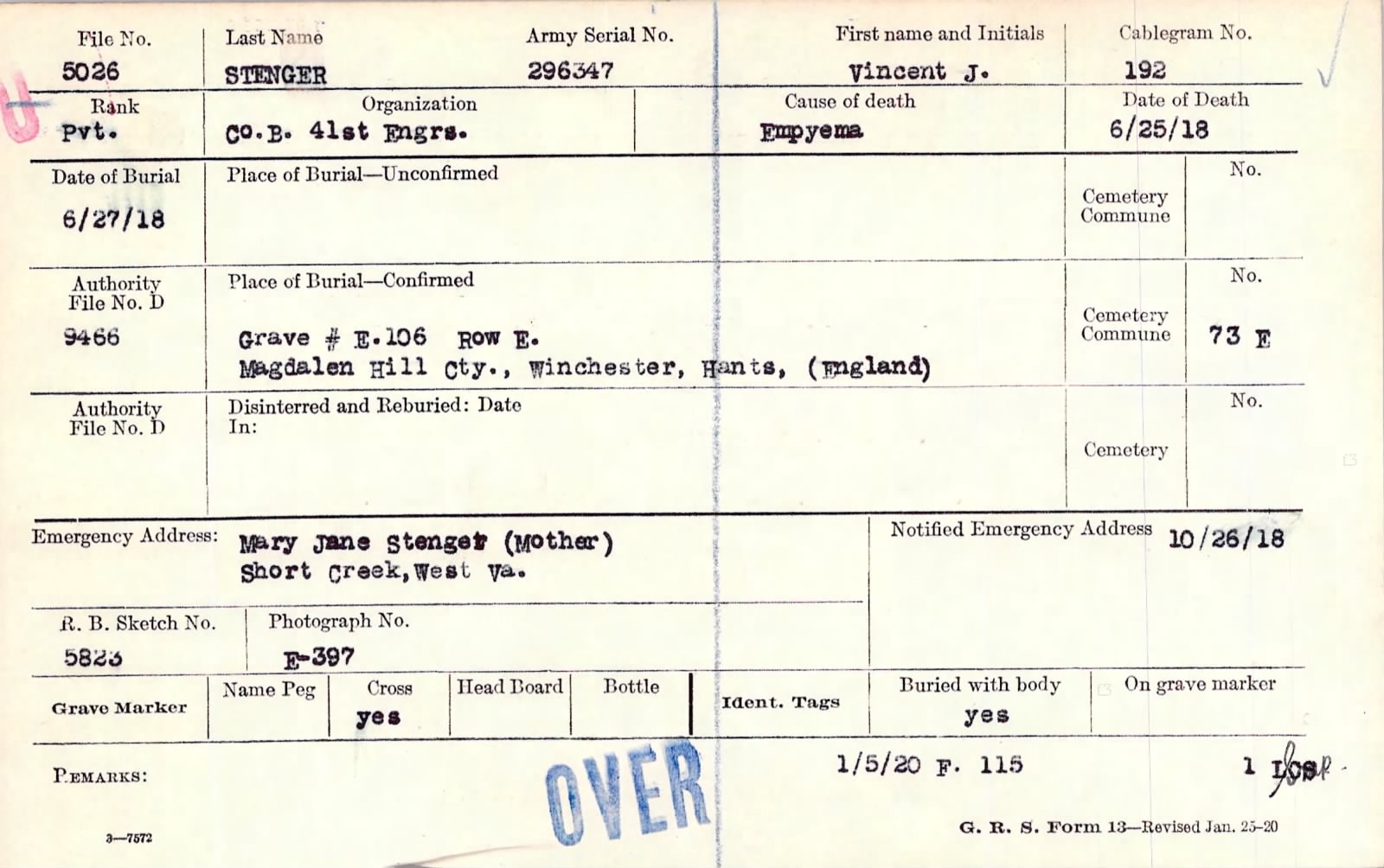
Private Vincent Stenger was moved to a hospital in England when the Olympic landed. He later died from influenza. His body was later moved hone for burial.
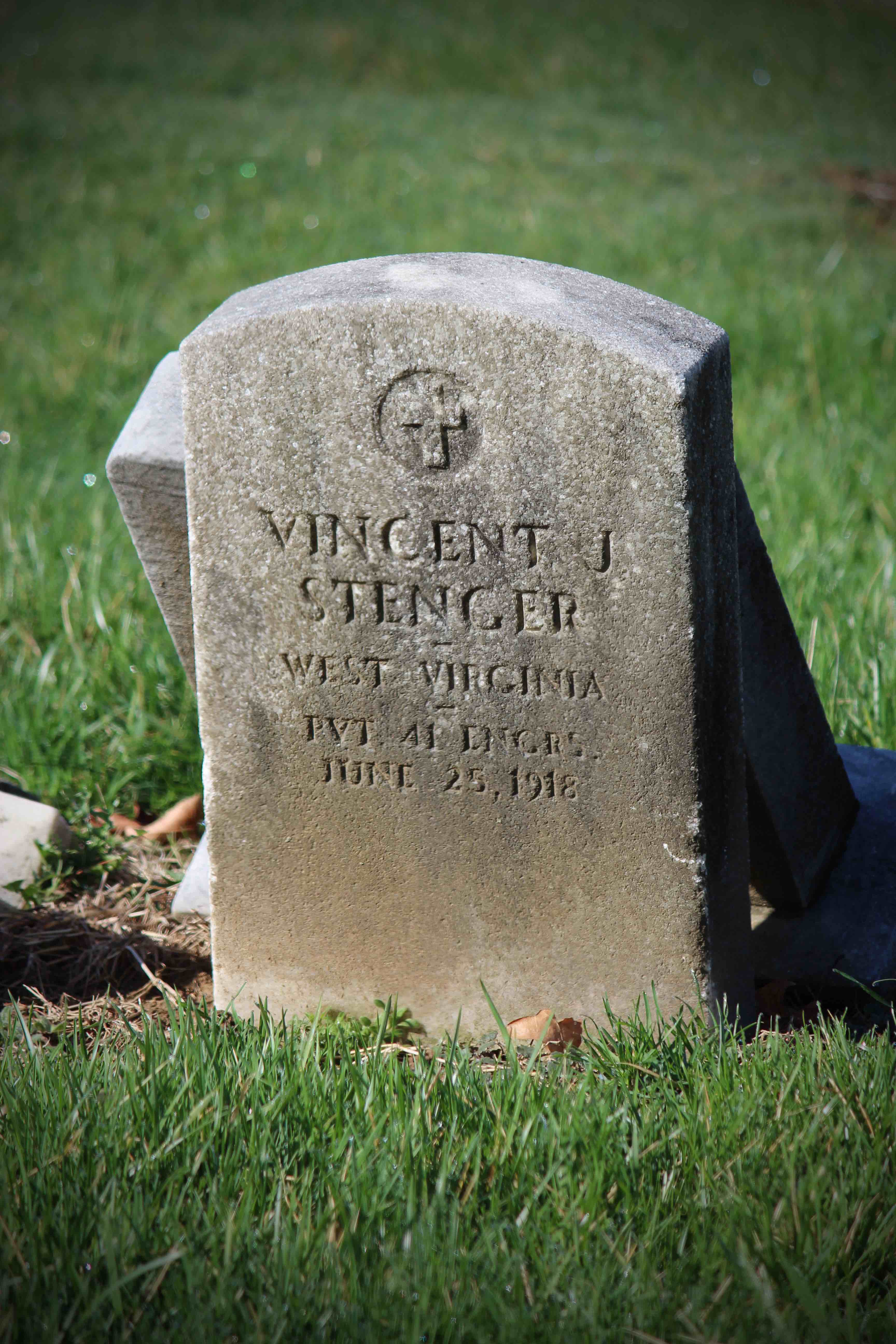
March 10th the journey was continued. Crossing the channel from Southampton, the 41st arrived at Le Havre , and went into rest camp for the second time. The next day they started into the unknown interior, crammed into the famous "Hommes 40s." After the usual jolts, the usual diet of bullybeef and hardtack, the usual complaints over whose feet were on your chest the night before, and the usual pointless orders not to get out of the car, Headquarters arrived at the village of Bricon, in the province of Haute Marne, twenty miles from Chaumont G.H.Q.
For two weeks the detachment was the center of attraction for the inhabitants of Bricon, as they were the first Americans stationed there. By this time their permanent duties had been mapped out. The operation at Eclaron, Haute Marne, conducted by the 5th and 8th Companies, had assumed sufficient importance to be directed as a separate district, and 41st Headquarters was assigned to the new administration.
In the meantime Co. C, which was later styled the 40th Co. of the Twentieth Engineers, was also sent to Eclaron, and added to the working force of the camp. By this time the original plans for employment of the 41st as a road battalion had fallen through completely, and all its units had merged with older forestry establishments.
Co. A (the 38th Co.) was attached to the Second Battalion, Epinal District, and arrived April 8th at Chatenois, 10 miles east of Neufchateau, where they were at once added to the force of the 15th Co., logging and operating a French mill. From this time on to the Armistice the adventures of the 38th and 15th Companies were shared in common. 80 men of the 38th were sent to Hortes, 20 miles east of Langres, to assist the 15th detachment operating a camp and native mill. A further mixed detail took over a French mill at Lamarche, Vosges, June 12th, and a smaller force opened a tie camp at Merrey, Haute - Marne. Both camps were abandoned in August, and the forces moved to Gironcourt, where an American mill was built, with a capacity of ten thousand board feet.
Sweeping changes occurred August 28th, when the 38th and 15th were relieved from duty in the Central or Chatenois area of the Epinal District and moved to the First Army Area in the Toul sector. From this time on the duties of the outfit were of a mobile nature. All through the region, covered by the First and Second Army operations, small camps were run, in some cases supplemented by portable mills. The 38th were represented at most of the 14 camps, including three in the Argonne Forest.
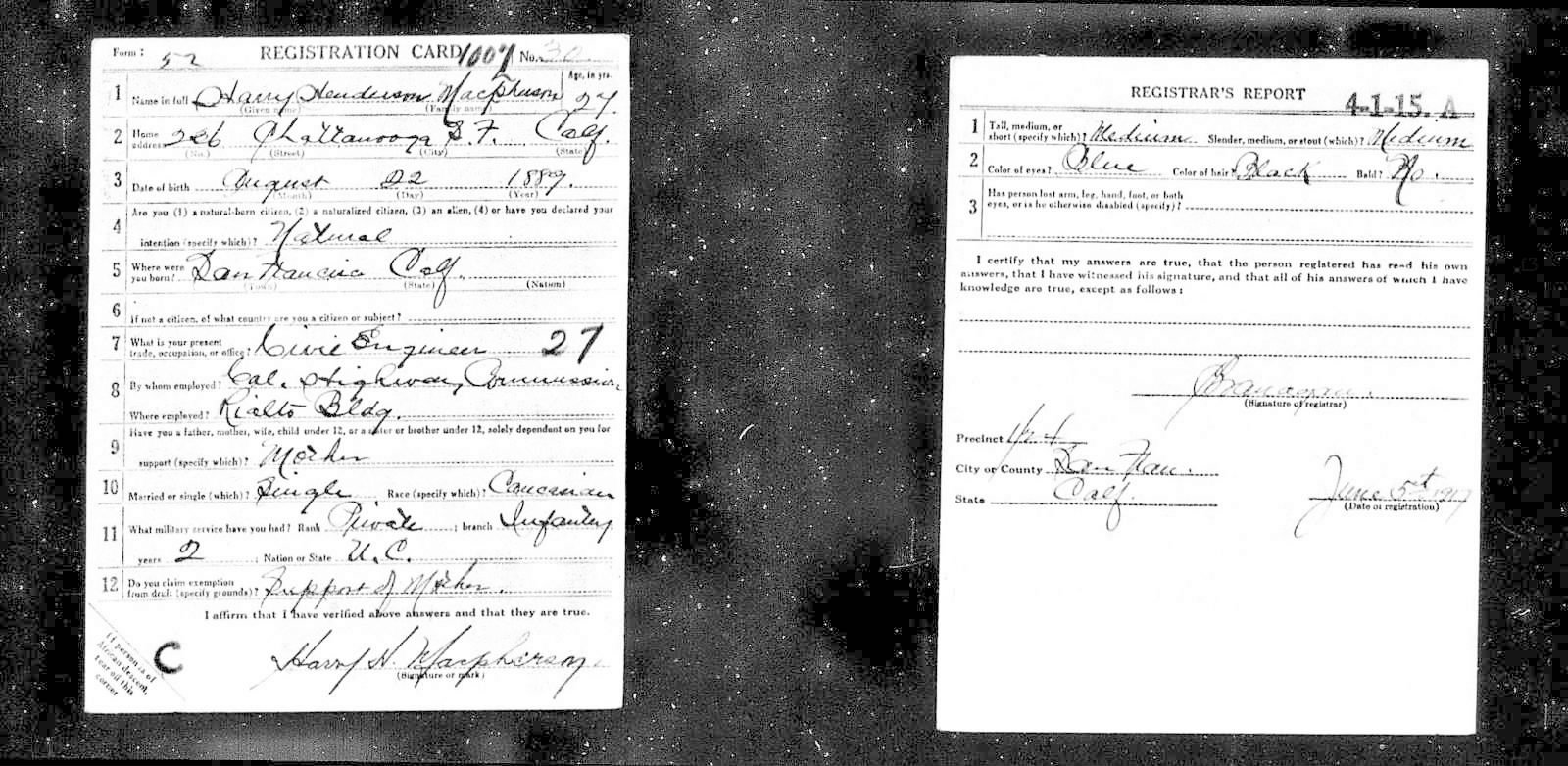
It was during this period that the most tragic incident in the career of the company occurred. Captain Harry E. McPherson, who was in charge of the mill at Ippecourt, near Soully, undertook a reconnaissance of newly won ground with a view to moving camp forward as soon as the lines were advanced. Accompanied by Lieut. W. A. Fair, Medical officer attached to the unit and a Sergeant, the Captain traversed a clearing exposed to the enemy lines. A burst of machine gun fire opened, and the Captain fell mortally wounded. Lieut. Fair hurried to his assistance, regardless of the fusillade, and met death at his side. A determined stand by the Germans made the spot a no man`s land for several days; when the ground was finally won the bodies had been interred, and their location could not be determined.
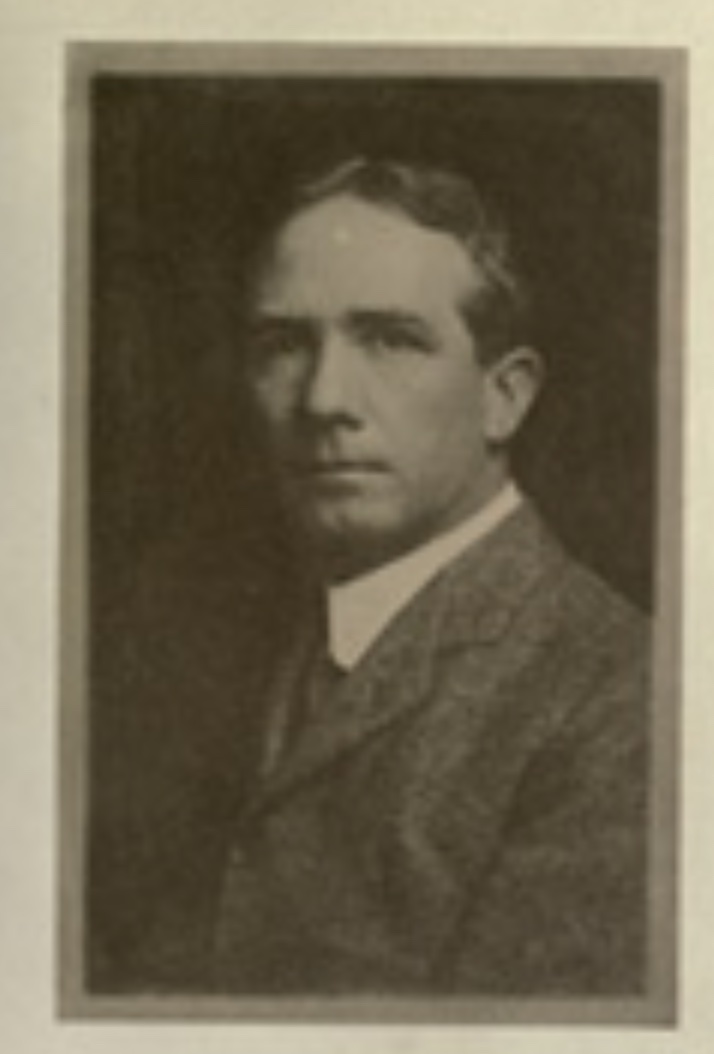
Captain Macpherson |
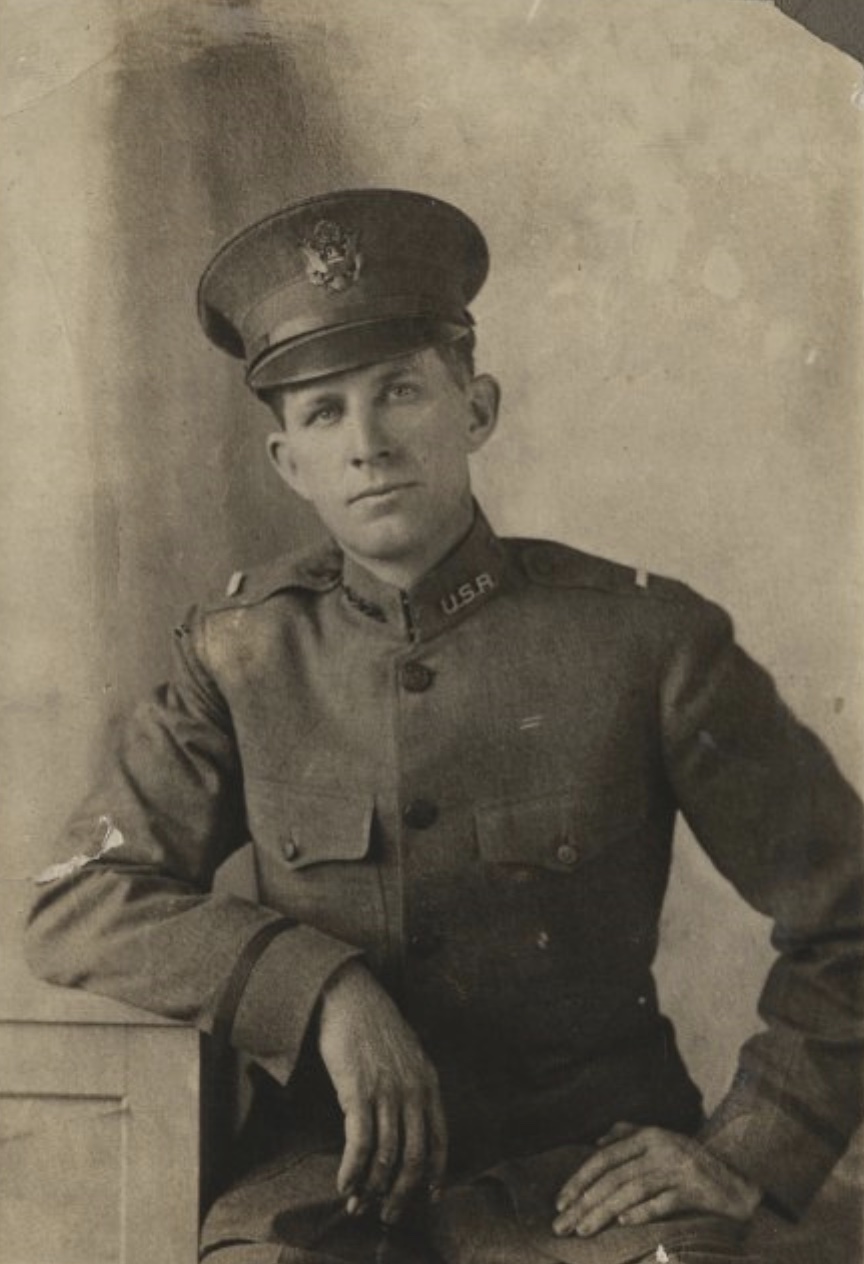
Lieutenant Fair |
|---|
For Lieut. Fair's bravery he was awarded a posthumous Distinguished Service Cross--the only such decoration accorded a member of the Twentieth Engineers, and the only decoration awarded for other than executive service.
The memory of Captain McPherson and Lieut. Fair is revered by the veterans of the Company. The Captain had served with the 41st since its inception, and is remembered by those he led as a man of honor and ability.
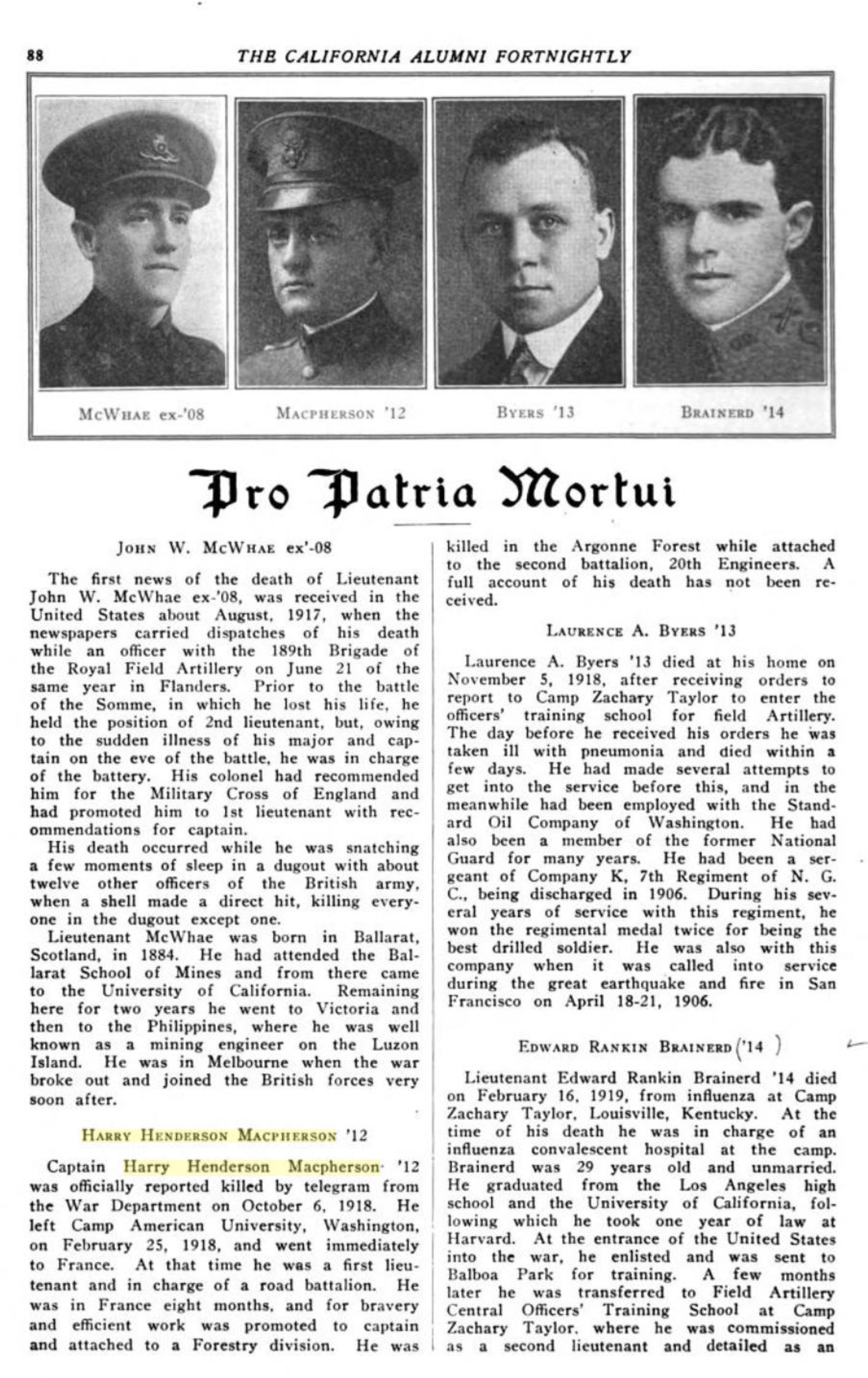
Upon the cessation of fighting, the 38th was gradually brought together, and resumed company organization at Bains-les-Bains, Vosges, about the middle of December. Here they resumed routine work, and busied themselves at fuel production. Early in April they journeyed to Tours, and served for two months on miscellaneous assignments, including convoy duty. Early in June they moved on to LeMans, accompanied by the 39th (Co. B of the 41st), and sailed from St. Nazaire the 14th, on the transport ''Texan,'' which also carried the 22nd Co., Eighth Battalion. They landed at Newport News the 26th.
The 39th Co. was attached throughout to the Dijon District, under the Third Battalion administration, in the Department of Cote d'Or. Immediately after striking inland from Le Havre, the outfit reported at Vanvey, to assist Co. E of the Tenth Engineers at that operation. Here they labored until the timber available was exhausted, in July, when the force moved to St. Julian, 8 miles north of Dijon. The mill was rapidly built - a 20,000 capacity McDonough—and logging started on a large scale. The strength of the operation was increased to 600 by the addition of the 47th Co. Shortly after the Armistice as E of the Tenth was now designated, left for home and in April the 39th started westward, and rejoined the 38th Co.
Co. D (the 41st Co.), underwent a totally different course. From LeHavre they proceeded direct to the Landes region in the south, arriving at Pontenx March 15th, for duty with the First Battalion, Tenth Engineers. At first the unit was split up. Half the company joined the 33rd Co., assisting at their logging camp on Aureilhan River for a month, then transferring to the mill on the lake. Early in August the detachment was moved eastward to the hamlet of Sore, where they built a new mill.
In the meantime the other detachment had been detailed to reinforce the Bourricose detachment of the Tenth Engineers (32nd Co.) operating a 20,000 mill two miles east of Pontenx. September 14th the Bourricose camp was turned over to the 41st intact, and 32nd relieving the Sore outfit.
Though dangerously handy to the Burnt Area, the 41st drew a blank, and stayed on at their own camp until from overseas duty in May. They sailed aboard the "K. I. Luckenbach," May 17th, and were mustered out at Camp Merrit early in June.
Headquarters Detachment conducted the Eclaron District until its abandonment, then shifted to St. Dizier, whence they started in May, 1919, for Brest and Home.
The Forty-Second Engineers
Of all the Engineer troops incorporated in the Twentieth Regiment, perhaps the least heralded and least known was the second of our three original auxiliary Battalions, the 42nd Engineers. While their sister units, the 41st and 43rd, were retained as Battalions of the Twentieth, and continued as units, though widely scattered, the 42nd was not accorded this recognition, and the historian must speak of them only in terms of what they were before their regimental colors were retired. The 42nd drilled and trained and went to France as a unit, but their personnel came back as separate and orphaned companies. To their credit be it said that no members of the Forestry Regiment brought back better records or a higher morale.
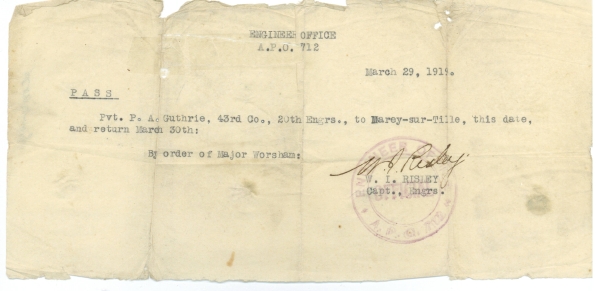
Organization of the 42nd was commenced early in March, 1918. Like the 41st and 43rd, the unit was primarily intended for road and bridge work in connection with operations. It was with this in view that officers and noncoms advanced. Even before organization was begun, it was apparent that separate units for such duties were neither necessary nor practical, but the knowledge was not stressed, through some hitch in military channels, and it was not until the Regiment arrived in France that the revised program was made known to its executives.
After a brief but intensive period of preparation, the unit left Camp American University at 5. P. M., May 8th, 1918. At 11 the next morning they boarded the transport "Abraham Lincoln," and sailed the next afternoon in convoy with twelve other carriers and a cruiser.
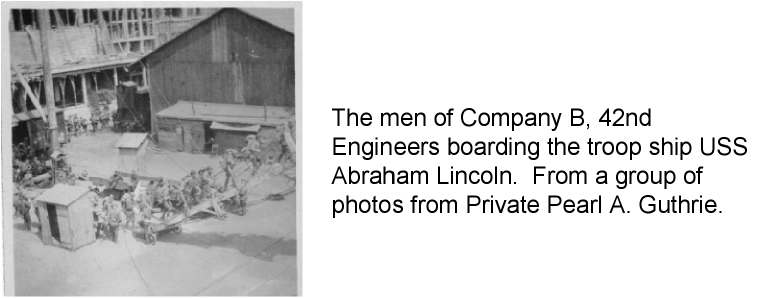
The trip was comparatively uneventful. The Lincoln dropped anchor at Brest May 22nd ; next day, at 3 P. M., the 42nd landed on French soil, and marched to the Camp Bougen rest camp. Their first overseas duty was the unloading of the boat, and when the cargo was cleared the anchor was already hoisted home and the screws revolving. The last man man ashore was Lieut. Glass, of Co. D. The next man to leave the "Abraham Lincoln" left in a hurry, as an enemy sub sank the big vessel on the homeward trip.
Twenty-four hours after the outfit reached camp, the prevailing confidence in immediate service at the front received a knock out blow, when orders arrived for dispersal of the Regiment and attachment of the companies to various units of the Twentieth Engineers for Forestry duty.
The scattering was rapid and thorough. Headquarters, Co. A, and half of Co. D were sent south to the Landes. Companies B and C went to the advance zone in the northeast. The remainder of Co. D also struck for the Vosges for temporary duty.
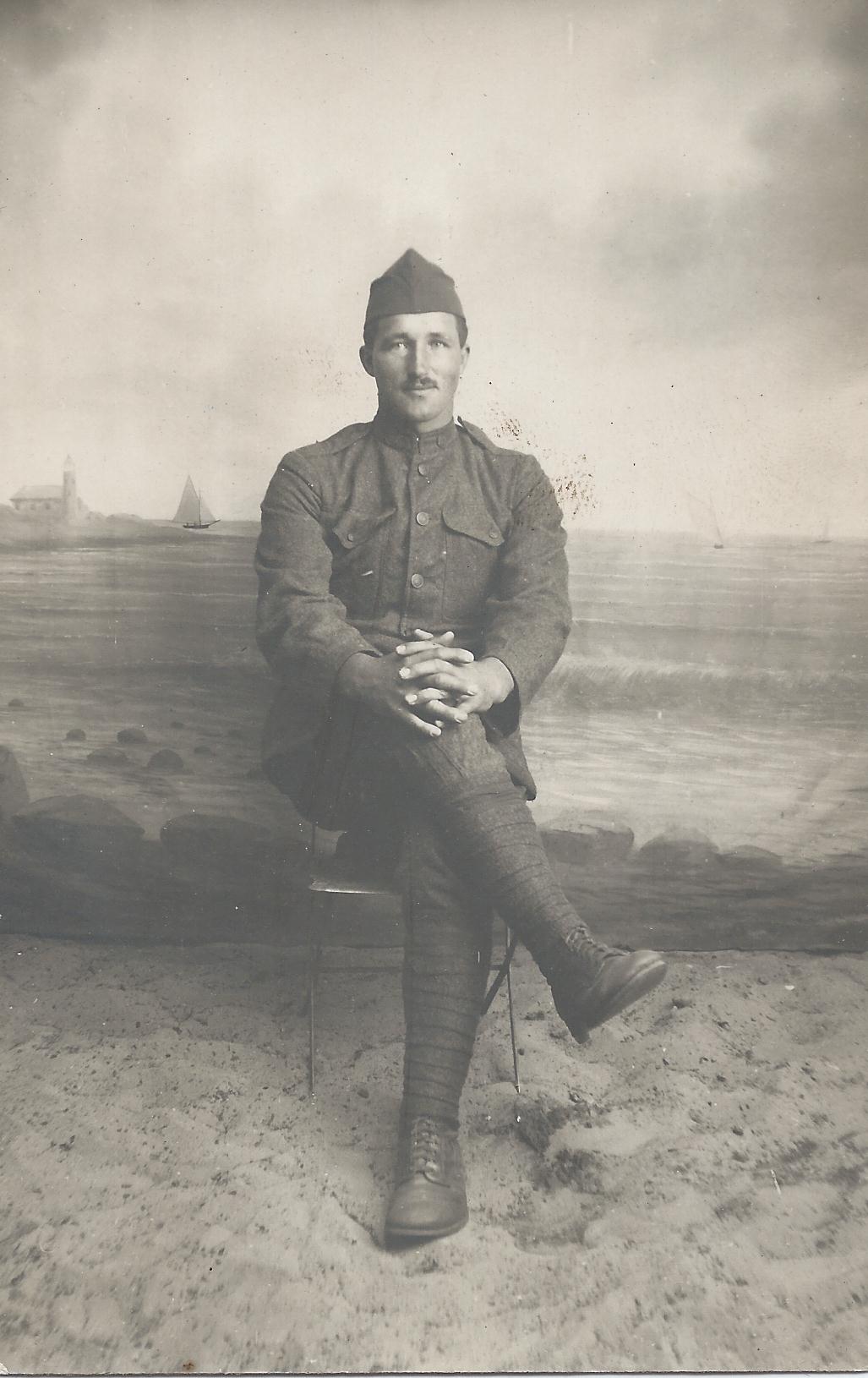
Private Stephen Chouinard, 45th Company
Click to read his family's story
From this time on, the story of the Forty-second is simply that of its component parts. Headquarters arrived at Pontenx-les-Forges, Landes, June 1st, and was attached for duty to the First Battalion of the Tenth Engineers. Shortly after, the detachment was transferred to Base Section No. 1, and ordered to St. Nazaire, where they severed connections with the Forestry Section.
Co. A, after the reorganization known as the 42nd Co., were assigned a sawmill operation at Sabres, in the Pontenx District. Although never recruited or organized for such work, the outfit took hold with alacrity, and within a month were cutting far more than the rated capacity of their mill. They stayed at Sabres all through the war period, and left the Landes only when the windup of the Burnt Area job released the bulk of remaining Forestry troops. Early in May they joined the homeward bound troops at Pontenx, and sailed from Bassens aboard the ship "K. I. Luckenbach," May 17th.
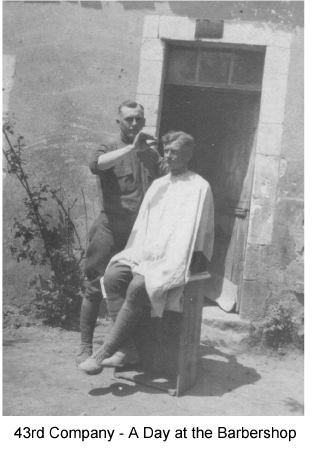
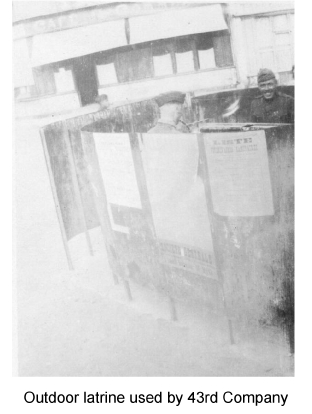
The 43rd Co., originally Co. B. likewise were fortunate enough to be held together. Their assigned station was the village of Vagney, in the Vosges mountains, not far behind the "quiet'' Lorraine sector. From May, 1918, until the middle of January, 1919, they logged and operated a mill, under direction of the Epinal District.
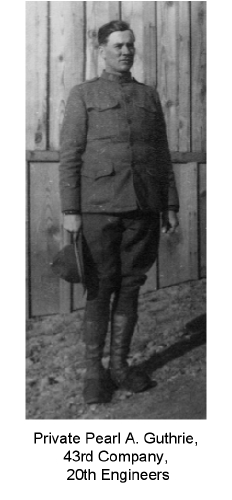
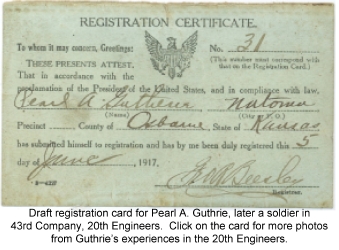
The Co. turned over the camp to a cleanup detail, and left, January 17th, for Orville, Cote d'Or, where they were employed for four months on road repair, chiefly along the national highway between Dijon and Langres. Upon their release from duty, May 16th, they headed for the coast, and after the inevitable delays, for home.
Co. C (the 44th Co.) was also assigned to the Epinal District. The northern unit of Co. D, (45th Co.), was first ordered to the northeast, and spent a month cutting fuelwood in the vicinity of Bazoilles-sur-Meuse, six miles from Neufchateau. The detachment was then transferred to the Bauge district in Brittany, and built a sawmill at Rennes, the ancient capital of the dukedom. As soon as the operation was producing, the outfit was ordered back to the Vosges, where various auxiliary duties held them till after the Armistice. They were then added to the Burnt Area expeditionary force, and arrived in Plantenx in February.
In the meantime the southern detachment, which reached the Landes early in June, was attached to the Fourth Battalion for service in the Mimizan District. The half-company was again divided, details joining the 11th Co., at Lamanchs, and the 12th at les Pleyres. A few weeks later, the units were assigned to operate a new 10,000 capacity mill at Bias, south of Mimizan of the 45th Co. had actually taken over the camp, when the superior persuasiveness of the commander of the newly-arrived 15th Service Co. reversed the program, and the 45 condemned to spend the duration as extra gangs in Battalion camps.
After the Armistice two of the Mimizan District mills were removed to the Burn, and the southern detachment to accompany the 12th Co. Early in March the 45th Co. were brought together, but immediately redivided among the three operations. Upon release, May 9th, the outfit was once more united, and left for home in company with the 42nd and for other Twentieth units.
Arriving at Hoboken June 1st, the units were ferried to a landing eight miles from Camp Merritt, and despite the many railway facilities available, were hiked the distance under full equipment and a blazing sun. The last vivid memory of the 42nd vets is that of a Major, leading the march in an auto, wildly condemning his subordinates for letting the men fill their canteens. It didn't matter, for the finish was in sight.
Upon dispersal, most of the outfit were sent to Camp Dodge for discharge. The northern central states had furnished by far the largest quota of the 42nd Engineers, though, like all the other Forestry battalions, all sections of the country were represented.